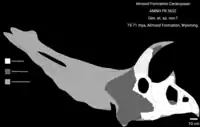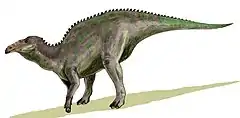| Almond Formation | |
|---|---|
| Stratigraphic range: | |
| Type | Geological formation |
| Underlies | Lewis Shale |
| Overlies | Ericson Formation |
| Lithology | |
| Primary | Sandstone |
| Other | Siltstone, shale, coalb |
| Location | |
| Coordinates | 41°36′25″N 109°13′34″W / 41.60694°N 109.22611°W |
| Region | Wyoming |
| Country | United States |
 Southwestern Wyoming, incl. Almond formation | |
The Almond Formation is a geological formation of Late Cretaceous (Late Campanian-Early Maastrichtian[1]) age in Wyoming. It was deposited in marsh, deltaic, lagoonal, estuarine, and shallow marine environments along the western shore of the Western Interior Seaway. It consists primarily of fine- to medium-grained sandstone, siltstone, shale, and coal.[2] Fossils from the Almond Formation include remains of dinosaurs[3] and plants.[4]
Vertebrate paleofauna
Dinosaurs
Color key
|
Notes Uncertain or tentative taxa are in small text; |
| Dinosaurs of the Almond Formation | ||||||
|---|---|---|---|---|---|---|
| Genus | Species | Location | Stratigraphic position | Abundance | Notes | Images |
|
Indeterminate |
Represents a new genus and species of unnamed ceratopsid |
 Unnamed chasmosaurine ceratopsid | ||||
|
Indeterminate[5] |
||||||
|
Indeterminate[5] |
||||||
|
Indeterminate[5] |
||||||
|
Indeterminate[5] |
||||||
|
P. lacustris[5] |
||||||
|
Indeterminate[6] |
||||||
|
Unnamed chasmosaurine ceratopsid[7] |
Unnamed |
Misidentified as Anchiceratops, it is actually a new species of Pentaceratops-like form that is the sister taxon to Bisticeratops.[8] Holotype was discovered in 1937. | ||||
See also
Footnotes
- ↑ Fowler, Denver Warwick (2017-11-22). "Revised geochronology, correlation, and dinosaur stratigraphic ranges of the Santonian-Maastrichtian (Late Cretaceous) formations of the Western Interior of North America". PLOS ONE. 12 (11): e0188426. Bibcode:2017PLoSO..1288426F. doi:10.1371/journal.pone.0188426. ISSN 1932-6203. PMC 5699823. PMID 29166406.
- ↑ Kieft, R.L., Hampton, G.J., Jackson, C.A.-L., and Larsen, E., 2011. Stratigraphic architecture of a net-transgressive marginal- to shallow-marine succession: Upper Almond Formation, Rock Springs Uplift, Wyoming, U.S.A. Journal of Sedimentary Research, vol. 81, p. 513-533.
- ↑ Weishampel, David B; et al. (2004). "Dinosaur distribution (Late Cretaceous, North America)." In: Weishampel, David B.; Dodson, Peter; and Osmólska, Halszka (eds.): The Dinosauria, 2nd, Berkeley: University of California Press. Pp. 574-588. ISBN 0-520-24209-2.
- ↑ Stockey, R.A., Rothwell, G.W., and Johnson, K.R., 2007. Cobbania corrugata gen. et. comb. nov. (Araceae): A floating aquatic monocot from the Upper Cretaceous of western North America. American Journal of Botany, vol. 94, no. 4, p. 609-624.
- 1 2 3 4 5 6 7 8 9 10 "3.12 Wyoming, United States; 4. Almond Formation," in Weishampel, et al. (2004). Page 584.
- 1 2 Listed as "cf. Thescelosaurus sp." in "3.12 Wyoming, United States; 4. Almond Formation," in Weishampel, et al. (2004). Page 584.
- ↑ Listed as "?Anchiceratops sp." in "3.12 Wyoming, United States; 4. Almond Formation," in Weishampel, et al. (2004). Page 584.
- ↑ Dalman SG, Jasinski SE, Lucas SG (2022). "A new chasmosaurine ceratopsid from the Upper Cretaceous (Campanian) Farmington Member of the Kirtland Formation, New Mexico". New Mexico Museum of Natural History and Science Bulletin. 90: 127–153.
References
- Weishampel, David B.; Dodson, Peter; and Osmólska, Halszka (eds.): The Dinosauria, 2nd, Berkeley: University of California Press. 861 pp. ISBN 0-520-24209-2.



